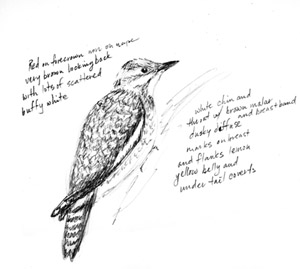Locality: Royal Avenue, Fern Ridge Reservoir, Lane Co.
Date: Nov 23, 2007
Time of Day: approx 09:30
Reporting observers address:
Mike Patterson
1338 Kensington Av.
Astoria, OR 97103
Light conditions: sunny
Optical equipment: 8x42 Bushnell Binoculars
Distance from bird: less than 20 meters
Duration of observation: 2 minute plus
Habitat: apple trees
Behavior: I first saw the bird while sorting through sparrows. It landed on the side of an apple tree sat for 30 seconds or so than moved to a different tree. After about a minute, it flew into a pine and disappeared from view. After a couple minutes it flew out of the pine and across the road into what I think was a crabapple. It was later relocated at the apples by David Irons.
Description: I immediately recognized it as a sapsucker. Its overall brownish appearances with buffy-white barring and well-defined face marking quickly eliminated the most likely Red-breasted Sapsucker.
Overall impression: Very brown looking and washed out.Similar Species: All regularly occurring, non-sapsucker Picids can
Head: Crown distinctly red with heavy brown streaking at forehead and around the perimeter. Whitish supercillium going all the way to the nape. No hint of red in the nape.
The red in the crown is atypical based on expected molt-timing,
but has been previously reported in a percentage of the
population (Mlodinow, et al 2006). Pyle (1997) indicates that
some juvenile males may have red in the crown from even
before the pre-basic molt and become fully adult Dec-May.
Brownish eye-stripe and malar stripe. Buffy-white throat.
Malar stripe bleeding into brownish breast bib.
Breast: Upper breast smudgy brown. Marks on mid-breast and
and flanks diffuse brown "V" marks. Belly and under-tail
coverts washed lemony yellow.
Back: Medium brown with extensive buffy-white barring
that contributed to the general washed-out look of the bird
Wings: dark brown with white patch
Tail: dark brown with whitish barring
be eliminated based on combined details. Red-breasted Sapsuckers
should have extensive amounts of red over the entire head. Juvenile
Red-breast Sapsuckers are very dark looking.
Red-naped Sapsucker is easily confused with Yellow-bellied
and
separation can be problematic. Most references
agree that juvenile
Red-naped Sapsucker should have red in the nape by November.
Advanced molting of the red crown in Yellow-bellied Sapsucker
is
far more common than delayed molt of the red nape in
Red-naped.
One would also expect the crown and nape feathers to
molt, more
or less at the same time.
Juvenile Red-naped Sapsucker should appear darker with
less white
barring on the back. This barring is most typically
confined to two
parallel rows. The general paleness (brown with
buffy white) of
the Royal Avenue bird combined with the absence of a
red nape
would seem to strongly favor Yellow-bellied over Red-naped
Sapsucker.
I do not see any compelling reason to suspect this to be a hybrid.
Previous experience: I have extensive experience
with regularly
occurring Oregon sapsuckers. This is the first
Yellow-bellied I've
seen of this age-class and plumage.
References:
Mlodinow, S.G, J.H.Barry and C.D.Cox. 2006. Variation
in Red-
naped and Yellow-bellied Sapsuckers. Birding, 38(6):42-51.
Pyle, P. 1997. Identification Guide to North American
Birds (part 1).
Slate Creek Press, Bolinas, CA.
Shunk, S.A. 2005. Sphyrapicus Anxiety: identifying
hybrid sapsuckers.
Birding, 37(3):289-298.
Sibley, D.A. 2000. Sibley Guide to Birds. Alfred A. Knopf, NY.
Winkler, H., D.A.Christie and D.Nurney. 1995. Woodpeckers:
an
identification guide to the woodpeckers of the world.
Houghton
Mifflin, Boston.

Drawing done 24hrs+ after original sighting from field
sketches and written notes.